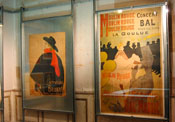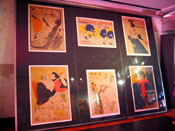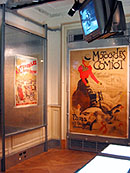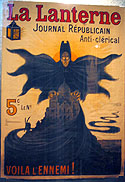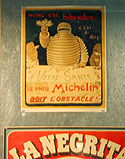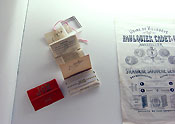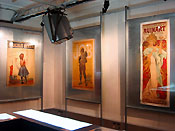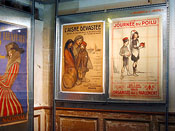The browser will either open the file, download it, or display a dialog.
|
"La Belle Époque de la pub" |
||||||||
|
The Musée de la Publicité in Paris, a museum dedicated to the preservation of materials used in the advertisement of products, events, people, and even ideas, recently displayed hundreds of popular print images and material-culture objects from its holdings to demonstrate how the field of popular advertising emerged at the end of the nineteenth century. (The collection, which is part of the Union Centrale des Arts Decoratifs, is housed in the same building as the Musée des Arts Decoratifs.) "La Belle Époque de la pub" ("pub" being the French shorthand for "publicité") provided clues as to how a given product became significant or how a popular personality gained the status of an icon through images encapsulating a theatrical role or a well-known gesture. It also showed how certain issues or historical events fired the imaginations of artists, writers, or publicists and how these were interpreted in a variety of ways. |
|||||||||
| With the material organized around interpretive themes linked to French cultural life of the late nineteenth century, this exhibition successfully documented how image-makers lionized performers or increased the awareness and marketability of a given product. Large-scale posters that once adorned the sides of buildings were produced by some of the leading designers of the period; Parisians subliminally interacted with these colorful images. What made this exhibition particularly valuable was the intelligent way in which the posters were displayed. The juxtapositions between actual memorabilia and the prints dramatically revealed the power of the graphic arts in reaching the public. Visitors to the show were immediately drawn into the organizational matrix of the exhibition and guided into seeing the relationships between objects and the idea, personage, or product being promoted so that they could understand how publicity became a communicative tool for an entire society. | |||||||||
| On entering the exhibition, one came face to face with a panoply of well-known examples. Among these were Toulouse Lautrec's image of Aristide Bruant performing at the Ambassadeurs, Lautrec's Moulin Rouge dedicated to La Goulue (fig. 1), and Pierre Bonnard's fashionably dressed Parisienne used to advertise the avant-garde periodical La Revue Blanche (fig. 2). This overview of famous icons transported viewers back in time, enabling them to see the ways in which posters became icons of an entire age, even though they were here removed from the context of the society in which they were originally produced. The show was installed in several side rooms—separated by a corridor—where various themes pertaining to topics, products, or personalities of the moment were intelligently interpreted. The long central corridor was dominated by the huge poster of Théophile Steinlen's La Rue (fig. 3), which emphasized the power that this image had over the imagination of the public. The poster depicted a cross-section of the Parisian populace, and drove home the point that everyone, regardless of station, was immersed in visual culture in 1900. Simply walking down a street, as the visitor walked down this long corridor, the directness of these images could not fail to have an impact. No one could remain immune to their pull. Thus, as asserted at the outset of the exhibition, visual culture at the turn of the century occupied a very significant place in people's lives. | |||||||||
| Each thematic section of the exhibition employed wall labels, audiotapes of informational interviews, or historical films projected on television monitors to help viewers understand how people had reacted to various topical concerns at the turn of the century. In the room dedicated to the beginnings of a consumer society, considerable attention was devoted to the new places of consumption, especially the department store, and to the new modes of transportation that made consumption possible even beyond the urban center: the bicycle, the motorcycle, and the automobile. The new modes of transportation and their impact on society were visualized by major postermakers such as Steinlen, who, in his Motocycles Comiot of 1899 (fig. 4) humorously showed how a chic young woman on her motorized machine frightened geese out of her path while riding through the countryside. | |||||||||
|
|
|||||||||
|
Another area of the show focused on the aggressiveness of the press. As dailies and weeklies increased in number, publishers struggled to attract new readers and to keep the old ones. They began to actively solicit advertisements for the pages of their publications; likewise, an aggressive publicity campaign was launched, via posters, to advertise the existence of new publications. Publishers also intensified the rhetoric of their visual style. One ominous image dominated this section of the show. The poster for La Lanterne, a republican periodical opposed to the clerical domination of French society, represented a frightening figure of a vampire-like priest hovering over the newly constructed church of the Sacré Coeur in Montmartre (fig. 5). Contemporary Parisians would have understood that, in the battle between church and state, La Lanterne clearly opposed the control of the former over the latter, since this section of the city was considered the freest in the city. | ||||||||
| Another theme in the exhibition was the enlistment of postermakers by capitalists to create icons that would be instantly recognizable. Among the firms that readily understood the power of images was the tire manufacturer Michelin. Early on, its publicists created the large character known as Bibendum (Bib, for short) that became the company's logo. This cartoon figure, still in use today, is a comical personification of a tire, fat and round, with markings to represent tire treads. The first advertisements for Michelin tires were indeed comical (fig. 6). A second, and equally important consumer product was cigarette paper. Since one of the most famous advertising images of the turn of the century—Alfons Mucha's poster of a femme fatale smoking a cigarette—was produced in this era, the organizers of the exhibition went to some lengths to elaborate on this product, and even arranged some of the original Job papers in a glass case (fig. 7). The Mucha poster was not included in the show, but the first poster designed for Job was on display; this featured a chimney sweep rather than a beautiful woman (fig. 8). During the 1890s, as the company tried to expand its audience, it targeted women and a more fashionable, international crowd by exchanging the early male icon for the female one. In the end, it was Mucha's image that became forever linked with Job in the mind of consumers from this era and beyond. | |||||||||
| The exhibition's final room was dedicated to the ways in which artists were enlisted in the war effort. World War I had devastating effects on France. Tens of thousands of soldiers were killed or maimed and countless families uprooted, especially in the northeastern part of the country. Steinlen, still a powerful propagandist in 1918, created an evocative poster dedicated to the homeless of the Aisne (fig. 9). Similarly, Francisque Poulbot, among others, used images of innocent children to spur his countrymen to action and direct their anger toward France's enemies. | |||||||||
|
|
|||||||||
| By selecting examples from their extraordinarily rich lithographic collection and by integrating material-culture objects and films to provide a historical context, the curators of the Musée de la Publicité succeeded in bringing their ideas to life in a most effective way. They demonstrated clearly and with rare visual acumen how the graphic arts were used in nineteenth- and early twentieth-century France as the tools of promotion, education, and propaganda. They also showed that there were many artists working in this expanding field of commercial art. This display is a major start in the right direction, although the lack of an accompanying catalogue meant that only those with the good luck to be in Paris during the exhibition benefited from its lessons. | |||||||||
| Gabriel P. Weisberg Professor of Art History University of Minnesota, Minneapolis |
|||||||||


